|
Steam Ejector Air Conditioning
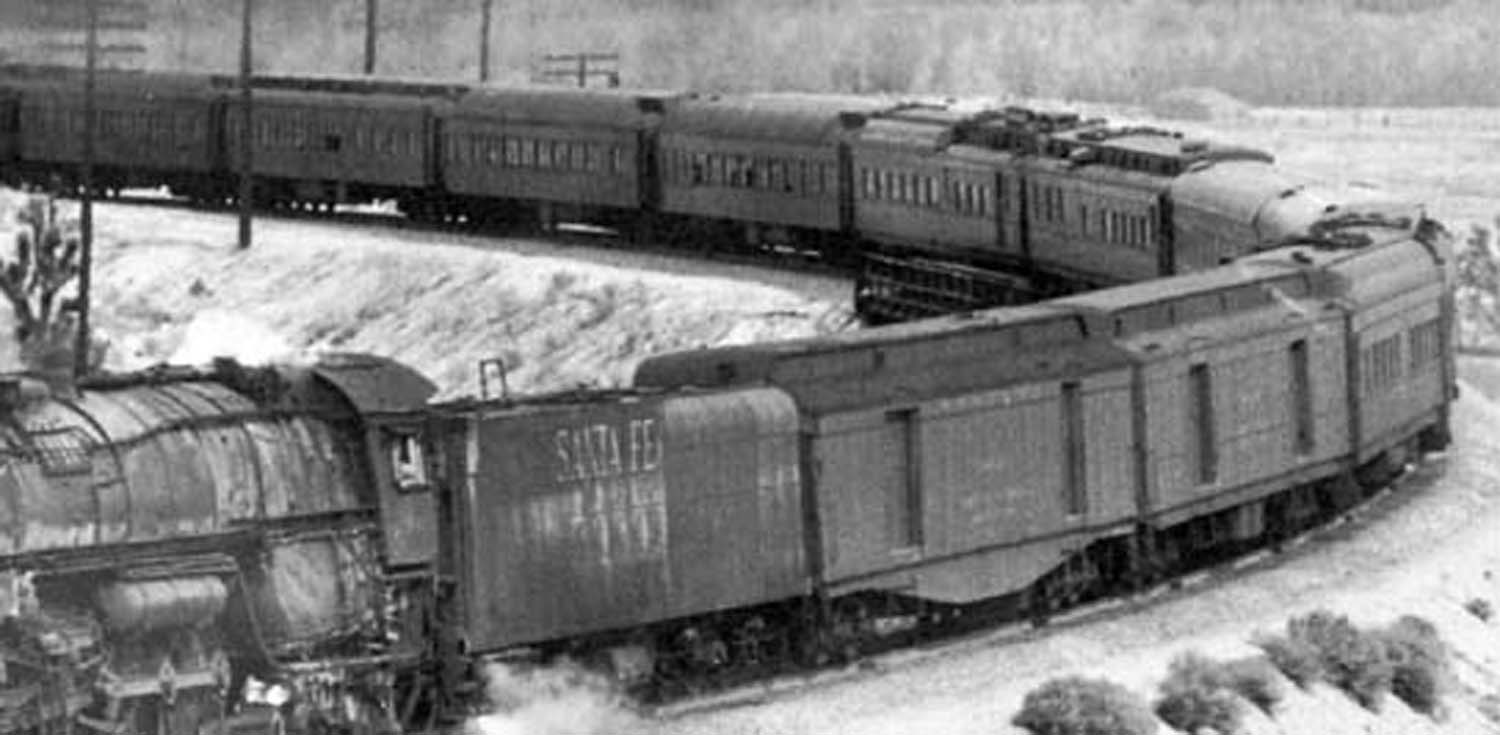
Photo by Robert Hale, 12/1/51 at Frost. From Santa Fe in the Mountains.
Santa Fe's first air conditioned car was diner 1418 built by Pullman in 1930. Due to its success, Santa Fe began a program of air conditioning its cars beginning with diners and lounges until much of its fleet was so equipped.
A variety of air conditioning systems were used by American railroads, and Santa Fe settled on steam ejector air conditioning for the majority of its cars. As a result the roofs have some unique hatches (often erroneously called "ice hatches"). The system has also been erroneously called "steam injector." There are six very visible items which air conditioned heavyweights should have:
1. A/C ducts: these were added to one or both sides of the clearstory to allow air movement from the cooling unit to ducts throughout the car. The placement and length depends on the specific car configuration.
2. Refrigeration Unit roof hatch (larger): usually placed at one end of the car with the shutters on the air duct side (see air duct below).
3. A/C Unit roof hatch (smaller): Either in the center of the roof or on the same end as the refrigeration unit.

Roof hatches, San Bartolo (ex. 1363) Age of Steam, Dallas, Jay Miller photo,.
4. Air vent: protrudes from the side of the clerestory beside the a/c unit roof hatch and opposite the a/c duct..

Air vent, 3231, Age of Steam, Dallas, Sandifer photo.
5. Condenser Water Pump and Valve Box.
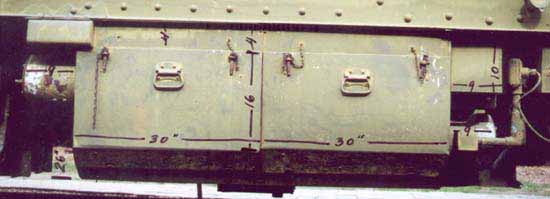
Condenser water pump and valve box on 1363, Age of Steam, Dallas, Sandifer photo

Condenser water pump 3010, Orange Empire, Perris, CA, Sandifer photo
6. Valve Closet
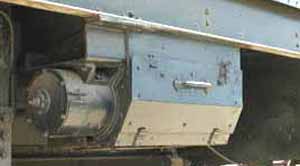 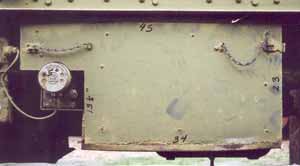
Valve closet, 1509, San Diego RR Museum, and 1363, Age of Steam, Dallas,Sandifer photo.
7. Generators: These could have been body mounted or truck mounted, depending on the car. Air conditioned cars also had two generators, one on each truck, to power the units. Non-air conditioned cars had one generator.
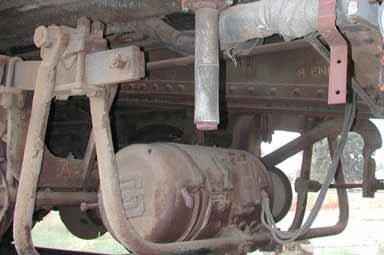
Generator 3010, Orange Empire Museum, Perris, CA, Sandifer photo
Jay H. Miller had a good article in the 1st Quarter 1987 Santa
Fe Modeler on SE Air Conditioning. His article includes photos of two cars at the Age of Steam in Dallas.
The problem for the modeler (and the manufacturer) is that there was no single standard for the visible equipment. For instance, Mr. Pullman, Tom Madden, writes (1-16-2008):
1. For heavyweights, there are roof-mounted SE systems that were
applied to Pullmans, and roof mounted SE systems that were applied to
Santa Fe-owned cars. Even though almost all such installations were
done at the Santa Fe's Topeka shops, and the Santa Fe ordered all of
the supplies and equipment, the visual things we model (roof hatches and underneath equipment boxes) were considerably different between
the two types.
2. The Santa Fe sent a full set of drawings of Pullman-style SE
equipment to Pullman. Most of these are at the Newberry Library, and
have formed the basis for my research. No equivalent set of drawings
for Santa Fe-style equipment has surfaced so far. So we can model
Pullman-style SE equipment accurately, but for Santa Fe equipment we
are dependent on those dare devils like John Fiscella who have spent
time up on the roofs taking photos and measurements. And believe me,
when your feet are 14' off the ground, and you're standing on a
curved surface only 6' wide, with no handholds above your ankles,
things can be precarious!
3. Several years ago New England Rail Service obtained permission
from The Coach Yard to duplicate the CY SE roof hatches in resin and
offer them for sale. This was based on castings I made of those
hatches in a very tough, very hard, yet slightly flexible urethane
resin. This was the perfect material for the hatches – the clamp
handles would flex but never break and never lose their shape – but I
withdrew for several reasons. First, I could never find a set of two
CY or PRB hatch castings that were perfect. I tried six or eight
sets, and every casting had one or more missing or seriously
misshapen clamp handles. Fine for the individual modeler equipping a
few cars; not fine for a manufacturer to market them by the dozens,
all with the same flaws. Second, doing the casting was extremely
labor intensive. The resin is very viscous, the molds had to be
filled in vacuum, and the demold time was 12 hours, with the last six
hours requiring oven baking at 150 degrees F. All very doable for
small quantities, but… Third, once I found the Newberry drawings and
the Santa Fe car at Calistoga and realized the CY hatches were
completely wrong for Pullmans - and my interests were specifically
Pullman - it seemed pointless to put any more effort into those
hatches. So I killed that project, with apologies to Don Valentine.
4. Branchline Trains always intended to offer SE equipment for their
Santa Fe cars, and it's a source of great frustration to both Bill
Schneider and to me that it hasn't happened. Whether it will or not
is still up in the air. The parts have long since been designed, but
the toolmaker who is most qualified to do the job (the one who has
done all of Branchline's passenger cars) is now far too expensive.
Branchline's ownership also changed with the death of owner Howard
Chaet. Now his daughter and son-in-law are in charge. Many of you
will remember the 19-month delay in the introduction of Branchline's
passenger cars. The dispute that caused that delay was resolved
literally at the last possible minute, but the 19-month interruption
in potential sales wasn't good for anyone. Certainly not for
Branchline, and I can understand their decision (for now) to put
their money into their very successful RTR passenger and freight car
program (which requires no new tooling) rather than into some more
very expensive tooling. As I said, I understand that decision for
now…. (Side note: Branchline does indeed list SE equipment as being
available. This is the underbody unit as used by the Milwaukee Road,
and is supplied with every Branchline MILW Pullman.)
5. There is a tremendous amount of variety in both hatch covers and
underneath equipment boxes. Most of the installations took place in
1934, 1935 and 1936. Equipment design changed every year.
Fortunately, all of the Branchline Pullmans that received roof
mounted SE systems (8-1-2, 12-1, 10-1-2, 14 Sec) were equipped in
1935 and received identical systems. The Walthers 6-3 was A/C'ed in
1934, so its SE system was different. Also, the Branchline prototypes
had ducts on both sides, so their air conditioner units were mounted
to blow air along the length of the cars, with "Y"-shaped plenums
diverting the air flow to the two sides. The Walthers 6-3 is an all-
room car with the duct on only one side. Its AC unit was mounted
crosswise in the middle of the car, to blow air toward the car side.
It's air conditioner hatch cover is completely different from the
Branchline ones.
6. Now for some better news. I have been working, off and on, on
patterns for all of the variations of Pullman SE hatch covers. What
got me off dead center was Walthers' release of their HW Santa Fe
coaches with the clamp handles to be added by the modeler. That means
the hatch covers can be cast in conventional resin, and I forthwith
designed all of them in 3D CAD. A pattern plate containing parts for
three of the four needed air conditioner hatch covers was made using
stereolithography, a mold was made from that, and this quick & dirty
flash photo shows a couple of the resulting castings.
Here's a closer view.
All three hatches are the same width, but they are different lengths.
With six of these films I can create masters for casting all three
hatches.
And a view of my cluttered cast part staging area containing all
sorts of HW parts.
Another pattern plate containing the fourth A/C hatch cover and all
three cooling tower hatch covers is designed and ready for
stereolithography.
7. Now for the reality. Those who know me, know that my record for
completing projects isn't particularly good. I'm too easily diverted
by other interesting challenges. Also, as castings I can visualize
doing a few hundred hatch cover sets, maybe even into the (very) low
thousands. But not by the multi-thousands... I'll certainly go ahead
with all the hatch cover castings, but what's really needed is for a
manufacturer to step up and sponsor hard tooling. If not Branchline,
I can provide the designs in 3D CAD - for the underneath equipment as
well as the hatch covers.
As Madden points out, Santa Fe had their own currently undocumented designs in addition to Pullman's three different hatch covers for the steam ejector unit ("cooling tower")
and five different ones for the A/C unit, one of which was used on only
three cars.

For the HO modeler, there are two commercial options if you can find them. The Coach Yard originally produced a complete set in brass which includes 5 of the 6 items above (minus
the A/C ducts), and two truck mounted generators. It sold for $28, but eventually sold old. Bob Darwin made the patterns for those, from prototype
hatches on a Santa Fe Smoker Chair 3109 (renumbered 3136) now used as part of a commercial display of 6 cars at the depot in
Calistoga, CA. This car was built in 1929 and air conditioned in 1937. Today it has been altered to appear as a Southern Pacific observation, but that conversion was done for display purposed at Calistoga.
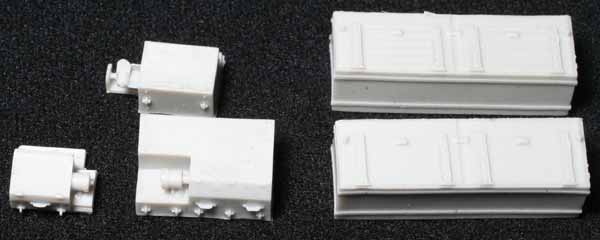
If you have a set, the underbody parts can be easily reproduced in resin.
Pecos River Brass got the hatch drawings from
Fred Hill, co-owner of The Coach Yard, and these roof hatches were virtually identical and available until 2007. There may be some around.
The CY/PRB hatches do not represent anything produced by Pullman. They must be a Santa Fe design. They are 6'10" long X 5'3" wide and 4'5" long X 4'7" wide. We assume that they were only used on three cars, Santa Fe Smoker Chair 3134, 3135, and 3136. CY/PRB used these on all Hwt models assuming that they were correct for all, a false assumption.
In 2007 Walthers released a 3060 class ATSF coach with SEAC. The roof hatches for that are presumably based on the prototype car photographed and measured at a mid-west museum. I have been unable to verify the exact prototype. Those hatches are held in place by two small pins and are easily removed. They came without the hatch dogs applied, so the modeler must drill 72 (!) holes to attach the dogs. These hatches are 6'11" long X 5'11" wide and 5'11" X 5'11." It would be a simple task to resin cast additional hatches from these. Casting the handles as on the CY/PRB parts is beyond the capacity of most people.

The Refrigeration Hatch has shutters which normally are on the duct side of the car. The Walther's car has this reversed. It is an easy job to pop the hatch off and turn it around.
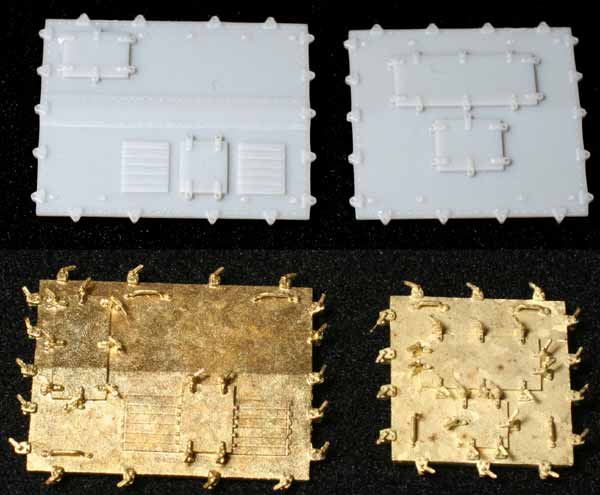
Comparison of CY/PRB and Walthers hatches, Sandifer photo
Madden's research into the Pullman cooling tower hatches includes two designs that are 5'4-5/8" wide and 6'5-7/8" long. The five air conditioning hatches included three that are 4'8-1/8" wide and two smaller versions. The length was 5'5-1/8", 5' 1/2", and 4'5-7/8" plus the two smaler versions.
The underbody equipment also varied in design and placement.
What this research shows is that you need photos and specific prototype information to create an accurate model.
Tom Casey describes now to scratch build SEAC parts for a heavyweight diner.
Here are some photo pages:
|

















